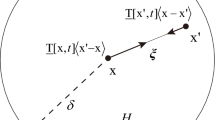Abstract
The present research work concerned with the transient stress distribution created in the composite material due to fiber breakage. Transient stress is the dynamic response of the system due to discontinuity in the fibers, from the moment of discontinuity to the moment of reaching the steady state. For this purpose, the dynamic equilibrium equations governing the composite lamina with finite dimensions and in the presence of discontinuity have been extracted and the effect of moving the location of the fiber discontinuity, changing the type of fibers and matrix, changing the width of the matrix, and finally the effect of the hybridization of the composite material on the stress concentration coefficient and shear stress created in it have been investigated. Shear-lag’s theory was used to derive the governing dynamic equilibrium equations, and the explicit finite difference method was applied to solve the differential equation of fiber displacement. The results of current study showed that the maximum stress concentration is created at the tip of the crack (place of fiber breakage) and with the increase in the number of broken fibers and the displacement of the fracture location toward the edges, the stress concentration coefficient and the amount of shear stress created also increase.












Similar content being viewed by others
References
L. Drzal, The role of the fiber-matrix interphase on composite properties. Vacuum. 41(7–9), 1615–1618 (1990)
A.C. Eringen, B.S. Kim, Stress concentration in filamentary composites with broken fibers. Princeton Univ NJ Dept of Aerospace and Mechanical Sciences (1973)
W. Ko, A. Nagy, P. Francis, U. Lindholm, Crack extension in filamentary materials. Eng. Fract. Mech. 8(2), 411–418 (1976)
H. Fukuda, T. Chou, Stress concentrations in a hybrid composite sheet. J. Appl. Mech. 50, 845–848 (1983)
J. Rossettos, M. Shishesaz, Stress concentration in fiber composite sheets including matrix extension. J. Appl. Mech. 54, 723–724 (1987)
M. Nedele, M. Wisnom, Stress concentration factors around a broken fibre in a unidirectional carbon fibre-reinforced epoxy. Composites. 25(7), 549–557 (1994)
H. Fukuda, Stress concentration factors in unidirectional composites with random fiber spacing. Compos. Sci. Technol. 22(2), 153–163 (1985)
S. Souad, B. Serier, F. Bouafia, B.A.B. Bouidjra, S.S. Hayat, Analysis of the stresses intensity factor in alumina–Pyrex composites. Comput. Mater. Sci. 72, 68–80 (2013)
Y. Ma, L. Wu, L. Yu, E.A. Elbadry, W. Yang, X. Huang et al., Effect of fiber breakage position on the mechanical performance of unidirectional carbon fiber/epoxy composites. Rev. Adv. Mater. Sci. 60(1), 352–364 (2021)
B. Fazlali, S.V. Lomov, Y. Swolfs, Fiber break model for tension-tension fatigue of unidirectional composites. Compos. B Eng. 220, 108970 (2021)
S. Bahl, A.K. Bagha, Finite element modeling and simulation of the fiber–matrix interface in fiber reinforced metal matrix composites. Mater. Today Proc. 39, 70–76 (2021)
J.M Hedgepeth, Stress Concentrations in Filamentary Structures. National Aeronautics and Space Administration (1961)
D.L. Logan, A First Course in the Finite Element Method (Thomson, Toronto, ON, 2007)
S.C Chapra, R.P. Canale, Numerical Methods for Engineers (Mcgraw-hill, New York, 2011)
Author information
Authors and Affiliations
Corresponding author
Additional information
Publisher's Note
Springer Nature remains neutral with regard to jurisdictional claims in published maps and institutional affiliations.
Rights and permissions
Springer Nature or its licensor (e.g. a society or other partner) holds exclusive rights to this article under a publishing agreement with the author(s) or other rightsholder(s); author self-archiving of the accepted manuscript version of this article is solely governed by the terms of such publishing agreement and applicable law.
About this article
Cite this article
Yaghoubi, S., Shishesaz, M. A Novel Approach to Investigate Transient Stress Distribution Caused by Fiber Breakage in Simple and Hybrid Composite Materials. J Fail. Anal. and Preven. 23, 325–338 (2023). https://doi.org/10.1007/s11668-022-01584-6
Received:
Revised:
Accepted:
Published:
Issue Date:
DOI: https://doi.org/10.1007/s11668-022-01584-6




